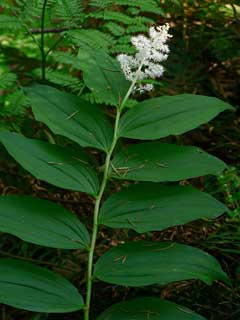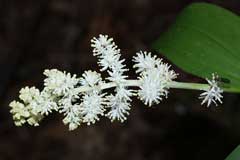 |
|
http://en.wikipedia.org/wiki/User_talk:Wsiegmund |
 |
| http://en.wikipedia.org/wiki/User_talk:Wsiegmund |
Translate this page:
Summary
Smilacina racemosa (L.) Desf. is a synonym of Maianthemum racemosum (L.) Link
Physical Characteristics

 Smilacina racemosa is a PERENNIAL growing to 1 m (3ft 3in) by 0.6 m (2ft).
Smilacina racemosa is a PERENNIAL growing to 1 m (3ft 3in) by 0.6 m (2ft).
See above for USDA hardiness. It is hardy to UK zone 4. It is in flower from May to June, and the seeds ripen from August to October. The species is hermaphrodite (has both male and female organs) and is pollinated by Insects. The plant is self-fertile.
Suitable for: light (sandy), medium (loamy) and heavy (clay) soils and prefers well-drained soil. Suitable pH: mildly acid and neutral soils. It can grow in full shade (deep woodland) or semi-shade (light woodland). It prefers moist soil.
UK Hardiness Map
US Hardiness Map
Synonyms
Vagnera racemosa. Maianthemum racemosum. (L.)Link. Smilacena racemosa
Plant Habitats
Edible Uses
Edible Parts: Shoots
Edible Uses:
Fruit - raw, cooked or made into jellies and molasses[2, 46, 55, 85, 102, 183]. The fruit is smaller than a pea but is produced in quite large terminal clusters on the plant and so is easy to harvest. It has a delicious bitter-sweet flavour, suggesting bitter molasses[85, 183]. The fruit is said to store well[207], it certainly hangs well on the plants and we have picked very delicious fruits in late October[K]. Rich in vitamins[177], the fruit has been used to prevent scurvy[213]. Some caution is advised since the raw fruit is said to be laxative in large quantities, though this is only if you are not used to eating this fruit[85, 102, 159, 183]. Thorough cooking removes much of this laxative element[183]. Young leaves - raw or cooked[102]. The young shoots, as they emerge in spring, can be cooked and used as an asparagus substitute[55, 85, 102, 159, 183]. Root - cooked[85]. It should be soaked in alkaline water first to get rid of a disagreeable taste[85, 102, 159, 183]. It can be eaten like potatoes or pickled[183].
References More on Edible Uses
Medicinal Uses
Plants For A Future can not take any responsibility for any adverse effects from the use of plants. Always seek advice from a professional before using a plant medicinally.
False spikenard was widely employed by several native North American Indian tribes who used it to treat a variety of complaints[257]. It is little, if at all, used in modern herbalism. The plant is contraceptive and haemostatic[213, 257]. A decoction is used in the treatment of coughs and the spitting up of blood[257]. Half a cup of leaf tea drunk daily for a week by a woman is said to prevent conception[213, 257]. a poultice of the crushed fresh leaves is applied to bleeding cuts[257]. A tea made from the roots is drunk to regulate menstrual disorders[213]. The root is analgesic, antirheumatic, appetizer, blood purifier, cathartic and tonic[257]. A decoction is said to be a very strong medicine, it is used for treating rheumatism and kidney problems and, when taken several times a day it has been used successfully in treating cancer and heart complaints[257]. The fumes from a burning root have been inhaled to treat headaches and general body pain[257]. The fumes have also been used to restore an unconscious patient and to bring an insane person back to normal[257]. The dried powdered root has been used in treating wounds[213]. A poultice of the root has been applied to the severed umbilical cord of a child in order to speed the healing process and is also used to treat cuts, swellings etc[257]. A cold infusion of the root is used as a wash for sore eyes[257].
References More on Medicinal Uses
The Bookshop: Edible Plant Books
Our Latest books on Perennial Plants For Food Forests and Permaculture Gardens in paperback or digital formats.

Edible Tropical Plants
Food Forest Plants for Hotter Conditions: 250+ Plants For Tropical Food Forests & Permaculture Gardens.
More

Edible Temperate Plants
Plants for Your Food Forest: 500 Plants for Temperate Food Forests & Permaculture Gardens.
More

More Books
PFAF have eight books available in paperback and digital formats. Browse the shop for more information.
Shop Now
Other Uses
Plants can be grown as a ground cover when planted about 45cm apart each way[208].
Special Uses
Food Forest
References More on Other Uses
Cultivation details
An easy plant to grow[233], it requires a deep fertile humus rich moisture retentive soil, neutral to slightly acid, that does not dry out in the growing season, and a shady position[200]. Requires a lime-free soil[233]. It does well in a woodland garden[200]. Hardy to about -20°c[200]. Plants take a few years to become established[208]. This species can be separated into two sub-species, S. racemosa racemosa being found in the east of the range whilst S. racemosa amplexicaule is found in the west[270]. One report says that the plant is apomictic (producing seeds without sexual fusion), though this needs to be investigated further[270]. The flowers have a gentle sweet perfume[245]. For polyculture design as well as the above-ground architecture (form - tree, shrub etc. and size shown above) information on the habit and root pattern is also useful and given here if available. The plant growth habit is a runner spreading indefinitely by rhizomes or stolons [1-2]. The root pattern is rhizomatous with underground stems sending roots and shoots along their length [1-2].
References Carbon Farming Information and Carbon Sequestration Information
Temperature Converter
Type a value in the Celsius field to convert the value to Fahrenheit:
Fahrenheit:
The PFAF Bookshop
Plants For A Future have a number of books available in paperback and digital form. Book titles include Edible Plants, Edible Perennials, Edible Trees,Edible Shrubs, Woodland Gardening, and Temperate Food Forest Plants. Our new book is Food Forest Plants For Hotter Conditions (Tropical and Sub-Tropical).
Shop Now
Plant Propagation
Seed - best sown as soon as it is ripe in a cold frame. The seed can be very slow to germinate, often taking 18 months. Stored seed should be sown in a cold frame as soon as possible, it may take 2 years or longer to germinate. Grow the seedlings on in a shady part of a greenhouse for their first year without pricking them out, giving them liquid or foliar feeds as required to ensure that they do not become nutrient deficient. Divide the young plants up into individual pots in the autumn when they are dormant, and grow them on for at least another year in a shady part of the greenhouse. When the plants have reached a sufficient size, plant them out in the autumn whilst they are dormant. Division in spring or early autumn. Very easy, larger divisions can be planted out direct into their permanent positions. We have found it best to pot up the smaller divisions and grow them on in a lightly shaded position in a cold frame, planting them out once they are well established in the summer.
Other Names
If available other names are mentioned here
False Solomon's seal, treacleberry, feathery false lily of the valley,false Solomon's seal, Solomon's plume, false spikenard.
Native Plant Search
Search over 900 plants ideal for food forests and permaculture gardens. Filter to search native plants to your area. The plants selected are the plants in our book 'Plants For Your Food Forest: 500 Plants for Temperate Food Forests and Permaculture Gardens, as well as plants chosen for our forthcoming related books for Tropical/Hot Wet Climates and Mediterranean/Hot Dry Climates. Native Plant Search
Found In
Countries where the plant has been found are listed here if the information is available
Weed Potential
Right plant wrong place. We are currently updating this section.
Please note that a plant may be invasive in one area but may not in your area so it’s worth checking.
Conservation Status
IUCN Red List of Threatened Plants Status :

Growth: S = slow M = medium F = fast. Soil: L = light (sandy) M = medium H = heavy (clay). pH: A = acid N = neutral B = basic (alkaline). Shade: F = full shade S = semi-shade N = no shade. Moisture: D = dry M = Moist We = wet Wa = water.

Expert comment
Author
(L.)Desf.
Botanical References
43200270
Links / References
For a list of references used on this page please go here
Readers comment
| Add a comment |
|
If you have important information about this plant that may help other users please add a comment or link below. Only comments or links that are felt to be directly relevant to a plant will be included. If you think a comment/link or information contained on this page is inaccurate or misleading we would welcome your feedback at [email protected]. If you have questions about a plant please use the Forum on this website as we do not have the resources to answer questions ourselves.
* Please note: the comments by website users are not necessarily those held by PFAF and may give misleading or inaccurate information.
To leave a comment please Register or login here All comments need to be approved so will not appear immediately.
|
Subject : Smilacina racemosa
|
|
|
|